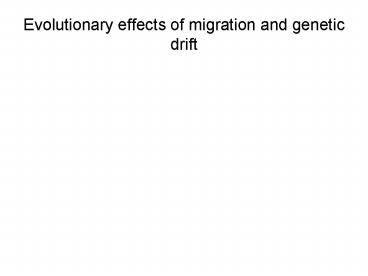Evolutionary effects of migration and genetic drift - PowerPoint PPT Presentation
1 / 20
Title:
Evolutionary effects of migration and genetic drift
Description:
Natural populations (unlike Hardy-Weinberg populations) are ... Pocket gopher. Thomomys bottae. 825 individuals. 50 geographic. localities. Two polymorphic ... – PowerPoint PPT presentation
Number of Views:98
Avg rating:3.0/5.0
Title: Evolutionary effects of migration and genetic drift
1
Evolutionary effects of migration and genetic
drift
2
Gene flow
Can counter natural selection
3
Nerodia sipedon
4
Genetic Drift
- Natural populations (unlike Hardy-Weinberg
populations) are finite in size. - Geographically structured so that mating is not
random. - Demes
- In small isolated populations, alleles can
fluctuate by chance (genetic drift). - Therefore, genetic drift is an evolutionary
force. - But, non-directional and cannot produce
adaptations.
5
- Sometimes a new population is established by a
small number of COLONISTS or FOUNDERS, through - 1. Dispersal (geographic)
- 2. Vicariance (geological)
- 3. Bottleneck (population is drastically
decreased in size -- reestablishment of the
population by a small number of founders. - All such populations experience a loss of genetic
variability. - e.g., a gene locus has 25 alleles. Ten
individuals found a new population. No way that
all of this allele variation can be represented.
6
- E.g.,
- Tristan da Cunha Island in southern Atlantic
one of most isolated places on earth - Colonized in 1816 by William Glass, wife, two
daughters - Joined later by a few additional settlers from
England - 1961 volcanic eruption population (294) taken
back to England, tested for various genetic
traits. - 145 years in isolation
- All residents homozygous (fixed) for nine genetic
markers - e.g., clinodactyly (dominant) present in the
Glass family. - Gene Flow
- Alternative glucose-6-phosphate dehydrogenase
allele arrived in 1827.
7
Allele diversity in Zosterops lateralis
8
- Because new small populations generally
experience slow growth, genetic drift continues
to reduce genetic variation. - Heterozygosity decreases and homozygosity
increases. - Genetic drift operates independently on
geographically isolated populations. - Frequency of an allele might increase in some
populations, decrease in others. - Populations diverge as different alleles become
fixed in each.
9
Computer modeling of genetic drift Start with
heterozygous individuals
10
(No Transcript)
11
(No Transcript)
12
Drift in a lab 107 experimental populations of
Drosophila Started with heterozygous individuals
bw25/bw Random draws of 8 males 8 females for
subsequent generations Population size kept at N
16
13
(No Transcript)
14
Natural Examples of Drift
Genotypic variation Pocket gopher Thomomys bottae
825 individuals 50 geographic localities Two
polymorphic gene loci
15
Greater Prairie Chicken
16
Habitat loss
17
Bottleneck
18
(No Transcript)
19
(No Transcript)
20
Desert 8,000 to 4,000 ybp Contiguous with SW
deserts Then retreat of deserts to SW
Present oak-hickory forest Relictual
populations 12 or so individs per deme































